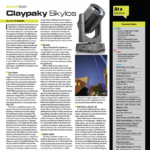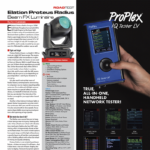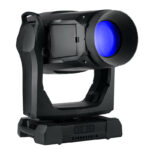Italian lighting manufacturer Clay Paky has brought the industry something much more than its series of Sharpy fixtures. Although it looks almost identical to a SuperSharpy from the outside, let’s have a look on the inside to see what the Mythos is all about.
What Is It?
The Mythos is tough fixture to describe because its capabilities are vast. To say that it is only an effect light, or spot light, or wash light, does not do it justice. It is truly an innovative multi-purpose luminaire, packed full of features for any type of application.
Programmatically, it has a “beam mode” and a “zoom mode.” At any time from the console, the user can select either mode, which unlocks distinctive features. The zoom mode is what I’m calling the standard mode or spotlight mode. It’s my default mode whenever I select a Mythos fixture on the console. Although there isn’t a “wash mode,” when you use the frost in zoom mode, it converts into a killer wash light. The alternate beam mode is specifically for super tight beams of light, or a Sharpy-style effect. While in this mode, select attributes (rotating gobos, prisms, and zoom) are unavailable due to the physical placement of the optics needed to achieve the parallel beam.
Lamp
The lamp source is a Philips MSD Platinum 20R, which is a 470-watt discharge lamp with built-in reflector. It is rated at 1,500 hours and has a color temperature of 7800K. Clay Paky’s design on the lamp housing is like nothing I’ve ever seen before. Typically, the lamp door is on the rear of the head, but the Mythos has no door. To access the lamp, the head covers must be removed — which is a quick and easy process, as the four screws are captive. The benefit of this design is to eliminate light leakage out of the back of the fixture.
I was amazed at the forced cooling system in this fixture. We all love to touch LED fixtures when they are on to feel how hot they are, but we hesitate to touch discharge fixtures since we don’t want to get burned. I approached the rear of the fixture with caution, but was surprised when my hand moved closer and closer to the unit until I was able to fully touch the rear of the fixture with my bare hand. It was warm, but not hot to the touch. Within a minute of dousing the lamp, I was able to open the fixture and touch the components inside. The thermal management is quite impressive and might say something about the longevity of the unit. To add to both the function of the lamp and the cooling system is the energy savings feature. It decreases the lamp power to 50 percent whenever the dimmer is at 0 percent (or all CMY flags are all set to 100 percent, which is black). This fixture has no hot re-strike capabilities, so it’s good that it cools down quickly.
Optics
The most impressive feature this fixture possesses is the optical system. When a gobo is projected, it stays in focus for the entire projected distance! For example, I shined this light in a warehouse where half of the gobo was on a wall 200 feet away and the other half 15 feet away. The gobo was crisp on both surfaces. This feature is awesome, because you no longer need to adjust the focus for different positions. If the Mythos is projected on a cyclorama 10 feet away and the next cue into the audience 150 feet away, the image stays crisp. The front lens is a large 6.7” diameter and the zoom range is a fantastic 4°-to-50°, which is a 1:12 ratio. And if 4° isn’t tight enough, switch to beam mode and insert an aperture fixed gobo to achieve a 0.5° output!
Color
There are two color systems intertwined in this fixture. First, is the CMY subtractive color mixing system. Each of the cyan, magenta, and yellow are on one-half of a gradient wheel. The other half of each wheel is filled with popular fixed color dichroic color filters .I was confused when I first learned this because I didn’t know how it would work on a console. There are six distinctive DMX channels for the color system and the fixture will always allow for latest takes precedent. There is no variable CTO, but there are CTO flags on the end of the cyan wheel. One can mix the red and yellow color flags while still being able to lock in the CTO color in place of the cyan hues on the gradient wheel.
I was able to operate the fixture with either CMY or fixed color wheels, both at the same time. Note that you cannot continuously spin the fixed color wheels and the resolution of the color mixing on the low end is noticeably not too smooth. But I’m glad Mythos has color mixing as it expands the color palette for lighting designers. When using the unit as a wash, with the frost at 100 percent, the color mixing improves and is much smoother.
Gobos and Prisms
The rotating gobo wheel contains six patterns, two of which are textured and multi-colored. The rotation is perfectly smooth, as good as any other light on the market. The static wheel features a total of 18 stamped gobos providing a variety of aperture reducing, break-ups, and patterns that look great in aerials. The rotating glass gobos are indexable and easily interchangeable. Clay Paky refers to its animation wheel as a visual graphics disk. It provides good effects at variable speeds.
My favorite features on the Mythos are the two rotatable prisms — a radial eight-faceted one and a linear four-facet prism. The eight-facet prism turns any of the aperture reducing gobos in a multi-ray effect. Add in the zoom and some rotation and now we have a Gatling gun look. I love to put the zoom on a ramp up and down to create a dynamic look as the eight beams open and close. Then add in a splash of color to complete the stellar look.
Adding either prism to any of the static gobos gives the appearance that they can rotate. The linear prism gives Mythos an aircraft landing light (ACL) effect that moves and rotates! Everyone loves the fans of ACLs, but to be able to achieve that in one fixture is incredible. And we haven’t even gotten to the animation wheel, which is perfect for fire/water effects or abstract movement underneath a gobo or color. The ability of this fixture to morph between the separate gobo wheels as well as the prism and animation wheel is stellar.
 Conclusion
Conclusion
I tested a pre-production fixture and it looked amazing and moved fast (comparable to a Sharpy). It can operate in 29 or 33 channel modes, the firmware is upgradable from fixture to fixture, and you don’t even have to power on the unit. The LCD battery backup suffices for firmware upgrades, DMX addressing, and menu functions. With the unbelievable amount of features, this 68-pound multi-purpose fixture is in a class of its own. It is a SuperSharpy plus a whole lot more…and no longer a myth.
At a Glance
 A Full-Featured Hybrid
A Full-Featured Hybrid
Take away the lettering on the yoke, and it might be difficult to distinguish Clay Paky’s hybrid Mythos and ACL beam type SuperSharpy moving head fixtures. Both use 470-watt light sources, too. But while the SuperSharpy is like a Sharpy on steroids, with a brighter, longer searchlight-style beams and more effects, the hybrid Mythos is even more versatile, with separate beam/zoom modes and a frost filter that lets it work as a wash light as well.
Pros: Beam/Spot/Wash multipurpose fixture, exceptional brightness, gobos stay in focus, great zoom ratio, no light leakage.
Cons: Color mixing is rough on low end, no variable CTO, some features not available in beam mode.
MSRP: $11,950
More Info: www.claypaky.it, www.actlighting.com



